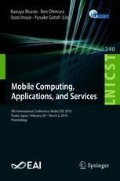Abstract
Whether a person is in company is an important indicator for several research fields such as monitoring a patient’s mental health states in clinical psychology or interruptibility detection in experience sampling. Traditionally, social activity is assessed using self-report questionnaires. However, this approach is obtrusive. The best solution would be an automatic assessment. Smartphones are suitable sensing systems for this task. In this paper, we investigate relations between being in company and place types. First, we present results of an online survey taken by 68 persons. Within the survey, we assessed how likely users are to be in company at specific place types provided by the Google Places API. We identified that places such as night club, bar, movie theatre, and restaurant are primarily visited in company. Places such as post office, gym, bank, or library are visited rather alone. Some place types are undecidable and require additional context information. As a next step, we ran an in-field user study to gather enriched real-world data. We logged temporal features, user activity, place type, and self-reported company indicators as ground truth. We gathered data of 24 participants over a period of three weeks. Using information gain and \(\chi ^2\), we identified that place type and hour of day correlate with being in company with statistical significance shown by Cramér’s V. Using machine learning, we trained different classifiers to predict being in company. We achieved an accuracy of up to 91.1%. Our approach is a first step towards an automatic assessment of being in company as it is more accurate than pure guessing. We propose to enrich it with further context information such as transportation mode or a more accurate activity classifier.
Access this chapter
Tax calculation will be finalised at checkout
Purchases are for personal use only
References
Amer, M.R., Xie, D., Zhao, M., Todorovic, S., Zhu, S.-C.: Cost-sensitive top-down/bottom-up inference for multiscale activity recognition. In: Fitzgibbon, A., Lazebnik, S., Perona, P., Sato, Y., Schmid, C. (eds.) ECCV 2012. LNCS, vol. 7575, pp. 187–200. Springer, Heidelberg (2012). https://doi.org/10.1007/978-3-642-33765-9_14
Bachmann, A., Klebsattel, C., Budde, M., Riedel, T., Beigl, M., Reichert, M., Santangelo, P., Ebner-Priemer, U.: How to use smartphones for less obtrusive ambulatory mood assessment and mood recognition. In: Adjunct Proceedings of Ubicomp 2015, pp. 693–702. ACM (2015)
Bergsma, W.: A bias-correction for Cramér’s and Tschuprow’s. J. Korean Stat. Soc. 42(3), 323–328 (2013)
Choi, W., Shahid, K., Savarese, S.: Learning context for collective activity recognition. In: 2011 IEEE Conference on Computer Vision and Pattern Recognition (CVPR), pp. 3273–3280. IEEE (2011)
Cohen, J.: Statistical Power Analysis for the Behavioral Sciences, 2nd edn. Hillsdale, New Jersey (1988)
Demiröz, G., Güvenir, H.A.: Classification by voting feature intervals. In: van Someren, M., Widmer, G. (eds.) ECML 1997. LNCS, vol. 1224, pp. 85–92. Springer, Heidelberg (1997). https://doi.org/10.1007/3-540-62858-4_74
Eagle, N., Pentland, A.S.: Reality mining: sensing complex social systems. Pers. Ubiquit. Comput. 10(4), 255–268 (2006)
Elhamshary, M., Youssef, M.: Checkinside: a fine-grained indoor location-based social network. In: Proceedings of the 2014 ACM International Joint Conference on Pervasive and Ubiquitous Computing, pp. 607–618. ACM (2014)
Exler, A., Braith, M., Schankin, A., Beigl, M.: Preliminary investigations about interruptibility of smartphone users at specific place types. In: Adjunct Proceedings of Ubicomp 2016. ACM (2016, to appear)
Faurholt-Jepsen, M., Frost, M., Vinberg, M., Christensen, E.M., Bardram, J.E., Kessing, L.V.: Smartphone data as objective measures of bipolar disorder symptoms. Psychiatry Res. 217, 124–127 (2014)
Halberg, F., Tong, Y.L., Johnson, E.A.: Circadian system phase - an aspect of temporal morphology; procedures and illustrative examples. In: von Mayersbach, H. (ed.) The Cellular Aspects of Biorhythms, pp. 20–48. Springer, Heidelberg (1967). https://doi.org/10.1007/978-3-642-88394-1_2
Liang, G., Cao, J., Zhu, W.: CircleSense: a pervasive computing system for recognizing social activities. In: 2013 IEEE International Conference on Pervasive Computing and Communications (PerCom) (2013)
Liao, L., Fox, D., Kautz, H.A.: Hierarchical conditional random fields for GPS-based activity recognition. In: Thrun, S., Brooks, R., Durrant-Whyte, H. (eds.) Robotics Research. Springer Tracts in Advanced Robotics, vol. 28, pp. 487–506. Springer, Heidelberg (2005). https://doi.org/10.1007/978-3-540-48113-3_41
Pejovic, V., Musolesi, M.: InterruptMe: Designing Intelligent Prompting Mechanisms for Pervasive Applications (2014)
Riboni, D., Bettini, C.: OWL 2 modeling and reasoning with complex human activities. Pervasive Mob. Comput. 7(3), 379–395 (2011)
Ryoo, M., Aggarwal, J.: Stochastic representation and recognition of high-level group activities. Int. J. Comput. Vis. 93(2), 183–200 (2011)
Ter Hofte, G.H.: Xensible interruptions from your mobile phone. In: MobileHCI 2007 (2007)
Trull, T.J., Ebner-Priemer, U.: Ambulatory assessment. Ann. Rev. Clin. Psychol. 9, 151 (2013)
Trull, T.J., Ebner-Priemer, U.W.: Using experience sampling methods/ecological momentary assessment (ESM/EMA) in clinical assessment and clinical research: introduction to the special section (2009)
Zheng, V.W., Zheng, Y., Xie, X., Yang, Q.: Collaborative location and activity recommendations with GPS history data. In: International World Wide Web Conference 2010, New York, USA (2010)
Author information
Authors and Affiliations
Corresponding author
Editor information
Editors and Affiliations
Rights and permissions
Copyright information
© 2018 ICST Institute for Computer Sciences, Social Informatics and Telecommunications Engineering
About this paper
Cite this paper
Exler, A., Braith, M., Mincheva, K., Schankin, A., Beigl, M. (2018). Smartphone-Based Estimation of a User Being in Company or Alone Based on Place, Time, and Activity. In: Murao, K., Ohmura, R., Inoue, S., Gotoh, Y. (eds) Mobile Computing, Applications, and Services. MobiCASE 2018. Lecture Notes of the Institute for Computer Sciences, Social Informatics and Telecommunications Engineering, vol 240. Springer, Cham. https://doi.org/10.1007/978-3-319-90740-6_5
Download citation
DOI: https://doi.org/10.1007/978-3-319-90740-6_5
Published:
Publisher Name: Springer, Cham
Print ISBN: 978-3-319-90739-0
Online ISBN: 978-3-319-90740-6
eBook Packages: Computer ScienceComputer Science (R0)

